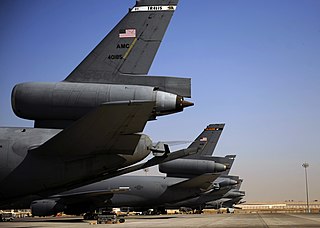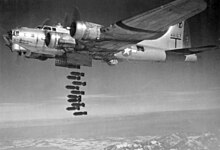
The 26th Space Aggressor Squadron is a unit of the United States Air Force located at Schriever Air Force Base, Colorado. It is part of the 926th Group and is the reserve associate of the 527th Space Aggressor Squadron.

The 42nd Attack Squadron is a United States Air Force unit assigned to the 25th Attack Group located at Creech Air Force Base near Indian Springs, Nevada. It flew the General Atomics MQ-9 Reaper unmanned aerial vehicle. The 42nd oversaw the training and combat deployment of aerial vehicle and sensor operators assigned to the Reaper.

The 10th Missile Squadron is a United States Air Force unit. It is assigned to the 341st Operations Group, stationed at Malmstrom Air Force Base, Montana. The squadron is equipped with the LGM-30G Minuteman III Intercontinental ballistic missile, with a mission of nuclear deterrence.

The 20th Bomb Squadron is a unit of the 2d Operations Group of the United States Air Force located at Barksdale Air Force Base, Louisiana. The 20th is equipped with the Boeing B-52H Stratofortress.

The 512th Rescue Squadron is part of the 58th Special Operations Wing based at Kirtland Air Force Base, New Mexico. It formerly operated the Bell UH-1N Twin Huey and currently operates the Sikorsky HH-60G Pave Hawk and the new HH-60W Jolly Green II helicopters training aircrew conducting search and rescue missions.

The 911th Air Refueling Squadron is part of the 305th Operations Group, and is stationed at Seymour Johnson Air Force Base, North Carolina. The squadron was the Air Force's very first active duty squadron under the command of a reserve wing. In October 2016, the 911th, formerly geographically separated from the 6th Air Mobility Wing at MacDill Air Force Base, Florida and operated as the active duty associate to the 916th Air Refueling Wing, became the first "I-Wing" or Integrated Wing. In July 2020, it was reassigned to the 305th Operations Group at the McGuire AFB entity of Joint Base McGuire–Dix–Lakehurst, New Jersey.

The 436th Training Squadron is a non-flying training squadron of the United States Air Force. The 436th Training Squadron, located at Dyess Air Force Base, Texas, is a geographically separated unit within Air Combat Command’s 552nd Air Control Wing, at Tinker Air Force Base, Oklahoma.

The 427th Reconnaissance Squadron is an active United States Air Force (USAF) unit assigned to Beale Air Force Base, California.

The 74th Reconnaissance Squadron is an active United States Air Force unit, part of the 9th Reconnaissance Wing at Beale Air Force Base, California. The squadron was first active during World War II as the 74th Aero Squadron. In 1933 it was consolidated with the 74th Pursuit Squadron, which had been organized as a reserve training organization in 1927, activating in the Panama Canal Zone, where it served during World War II as the 74th Bombardment Squadron.

The 49th Test and Evaluation Squadron is an active United States Air Force unit. Its current assignment is with the 53d Wing, based at Barksdale Air Force Base, Louisiana.

The 2d Operations Group is the flying component of the United States Air Force 2d Bomb Wing, assigned to the Air Force Global Strike Command Eighth Air Force. The group is stationed at Barksdale Air Force Base, Louisiana.

The 491st Attack Squadron is an active United States Air Force regular associate unit, stationed at Hancock Field Air National Guard Base, where it was activated in April 2019. It is assigned to the 49th Wing at Holloman Air Force Base, New Mexico and operates General Atomics MQ-9 Reaper unmanned aerial vehicles.

The 513th Electronic Warfare Squadron is a United States Air Force unit assigned to the 350th Spectrum Warfare Group at Eglin Air Force Base, Florida.

The 489th Attack Squadron is an active United States Air Force unit, stationed at Creech Air Force Base, Nevada, and operating MQ-1 and MQ-9 unmanned aerial vehicles. It was active at Beale Air Force Base, California as the 489th Reconnaissance Squadron from 2011 to 2015.

The 50th Attack Squadron is a squadron of the United States Air Force, stationed at Shaw Air Force Base, South Carolina, where it operates the General Atomics MQ-9 Reaper unmanned aerial vehicle. It is assigned to the 25th Attack Group, also at Shaw, and is a component of the 432d Wing, located at Creech Air Force Base, Nevada.

The 424th Bombardment Squadron is an inactive United States Air Force unit. Its last assignment was with the 307th Bombardment Wing at Lincoln Air Force Base, Nebraska, where it was inactivated on 1 January 1962.

The 89th Attack Squadron is a United States Air Force unit assigned to the 432d Wing as a tenant unit at Ellsworth Air Force Base, South Dakota. It has been active as a remotely piloted aircraft (drone) squadron there since 2011.

The 482d Attack Squadron is a United States Air Force unit, stationed at Shaw Air Force Base, South Carolina, where it is an operational squadron of the 25th Attack Group, operating the General Atomics MQ-9 Reaper unmanned aerial vehicle.

The 908th Expeditionary Air Refueling Squadron is a provisional United States Air Force (USAF) unit. It is assigned to the 378th Air Expeditionary Wing at Prince Sultan Air Base in Saudi Arabia. It has supported combat operations in Afghanistan, Iraq, and Syria from its previous location of Al Dhafra Air Base in the United Arab Emirates. The squadron has a varied background, having been formed by a series of consolidations of no fewer than five distinct units.

The 54th Airlift Squadron is a United States Air Force squadron stationed at Scott Air Force Base, Illinois. The squadron is an active duty associate unit aiding the 932d Airlift Wing in performance of its airlift mission. The first predecessor of the squadron was formed in August 1917 as the 54th Aero Squadron and served in France during World War II. In 1936, this unit was consolidated with the 54th School Squadron, a pilot training unit that became the 54th Bombardment Squadron, which became a demonstration unit for the Air Corps Tactical School, and later a test and evaluation unit for medium bomber aircraft and tactics.




























